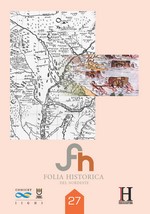Caravanas de hombres marchaban: el éxodo obrero en Entre Ríos. 1925-1945
DOI:
https://doi.org/10.30972/fhn.0271215Palabras clave:
Migrantes internos, crisis, sobrepoblación obrera, peronismoResumen
La migración de mano de obra es uno de los hechos más dramáticos y permanentes del capitalismo. La República Argentina formó su proletariado a partir de contingentes transatlánticos y de las regiones vecinas menos desarrolladas. Sin embargo, desde la década de 1920, las migraciones cambiaron. Las provincias pampeanas, receptoras de población hasta ese momento, comienzan a expulsar mano de obra sobrante. Un proceso que tiene por trasfondo la mecanización de tareas rurales que impone el éxodo como horizonte de vida a miles de trabajadores.
La llegada de estos obreros a las grandes urbes del litoral –Buenos Aires particularmente- ha dado lugar a una discusión historiográfica al respecto de la base social de quienes apoyaron a Perón aquel histórico 17 de octubre de 1945. En este contexto, aportamos con el presente trabajo al conocimiento de los motivos de la migración, el proceso histórico en marcha, el papel del Estado y los programas políticos en discusión sobre la migración, visto todo, desde una provincia expulsora: Entre Ríos. Para una construcción más fehacientes nos hemos basado en periódicos de diversas corrientes ideológicas, documentación estatal, material estadístico y memorias de exiliados, así como un repaso por las obras bibliográficas fundamentales.
Descargas
Publicado
Número
Sección
Licencia
Se deberá adjuntar una carta, en la que se declare que "el artículo titulado XXX”, es un trabajo original, que no ha sido ni total ni parcialmente publicado en ningún medio impreso o electrónico, que no ha sido remitido simultáneamente a otra publicación y que no se encuentra actualmente en proceso de evaluación en otra publicación. En el caso que sea aceptado para su publicación, transferimos los derechos de publicación a la revista Folia Histórica del Nordeste, quien asume los derechos para editar, publicar, reproducir, distribuir copias, electrónicas o multimedia e incluir el artículo en índices nacionales e internacionales o bases de datos. Por otra parte, dejamos constancia que las afirmaciones vertidas en el mismo son de exclusiva responsabilidad de las/los autoras/es". La carta deberá estar firmada por al menos uno de los autores.






